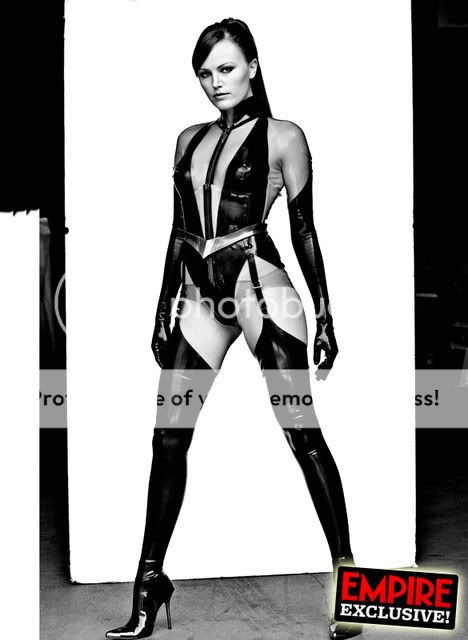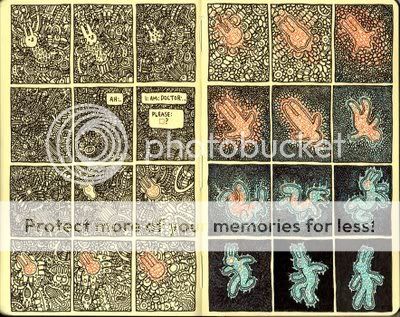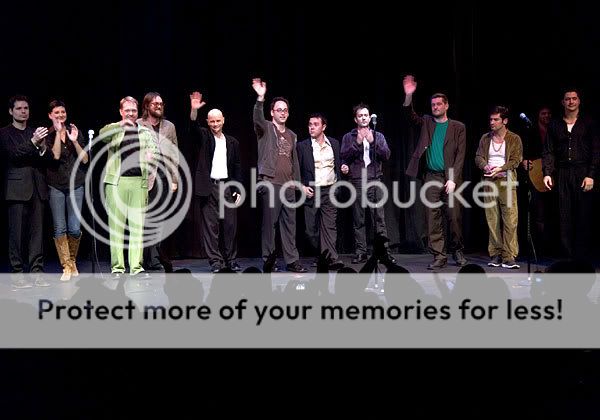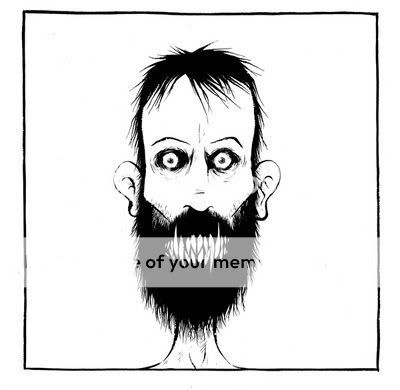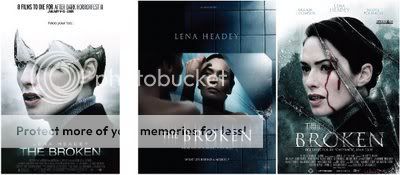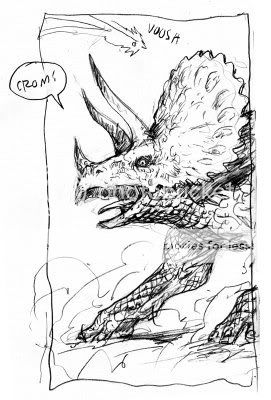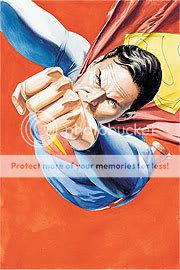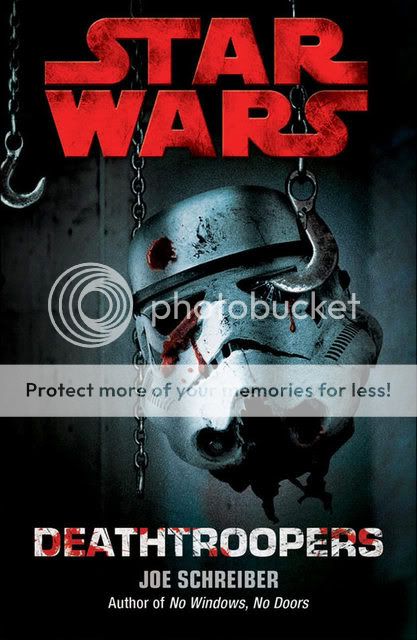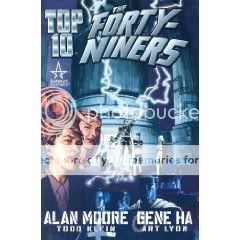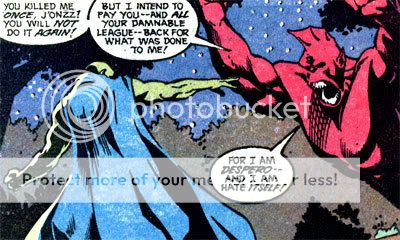Archive for January 31, 2009
Carnival of souls
January 31, 2009* The carnival of Acme Novelty Library #19 Final Crisis #7 continues: Here are 7 Reasons Why Douglas Wolk Loved Final Crisis. Kevin Melrose rounds up some info on the comic’s prominent, Dark Reign-undercutting use of a superheroic Barack Obama analogue. And the jibber-jabber about Morrison’s post-game comments about Wonder Woman continues in this comment thread.
* I know I swore off posting links to promotional stuff for Watchmen–you haven’t seen me link to those not-as-convincing-as-people-seem-to-think Dr. Manhattan period images, for example–but a couple of rather lovely image galleries went up recently. First there’s this series of black and white portraits of the main cast, taken from an upcoming book of such images. And second there’s this gallery of things like Nite Owl’s snowsuit, some of the World War II villains the Minutemen fought–you know, geeky stuff–taken from another, different upcoming book of such images. Regarding that first set, quite frankly, this picture of Malin Ackerman as Silk Spectre is stunning.
I can’t remember if I’ve discussed this on the blog or not, but one thing I was a little skittish about regarding the film was how drop-dead gorgeous Ackerman looks as Laurie, versus the somewhat more contextualized beauty of the character in the comic–she’s attractive to the other heroes in the book at least partially the same way the pretty girl in your office or your honors chem class is, you know? That girl probably couldn’t compete with an airbrushed Bar Rafaeli swimsuit layout, but because she shares your interests and is part of your world, why should she? But now I’m thinking that maybe it’s the same deal as those movie-fied costumes: Zack Snyder’s dealing with people’s expectations derived from Jessica Alba in a blue jumpsuit, and he has to shift things accordingly. Maybe that’s more thought put into the reasoning behind having a smoking hot woman wear next to nothing in your movie than is strictly required, I dunno, but that’s what I’m thinking. It’s also kind of amusing how much of the already meager costume they’re apparently taking out in post, as it were. (Links via everyone.)
* Heidi MacDonald notes concerns that a pair of British anti-obscenity laws could spell trouble for any number of media, though in the comment thread UK native Paul O’Brien says it’s much ado about nothing.
* Tom Spurgeon takes a look at a recent issue of Ed Brubaker and Michael Lark’s Daredevil, emphasizing the sheer craft chops on display. That’s something that impresses me more and more about Brubaker’s superhero work.
* Rambo in America? Sure, I’ll eat it.
* I’ll admit it, this this gallery of/McG interview about Terminator Salvation concept art and design work has me intrigued. (Via I forgot whom.)
* I’m not going to read the whole review because I haven’t seen the movie yet, but from what I skimmed, CRwM‘s argument that The Strangers should be viewed as an update of the slasher film rather than part of the post-torture-porn “home invasion horror” subgenre was interesting to me.
* Cryptomundo’s Loren Coleman reprints a 1940 article on the sasquatch that presents the phenomena strictly in terms of a possible early-man angle, which is interesting.
* Josh Cotter’s Driven by Lemons: still killin’ it.
* I liked this piece by Closed Caption Comics’ Molly Colleen O’Connell, who I believe is Italian-American.
* Independence Day at the Overlook Hotel. When I was at Wizard we frequently ate at a restaurant that had a picture that looked just like this. It was screwed to the wall, dammit.
* Morrissey naked. The pleasure and the privilege is yours.
* Finally, this made me do one of those “slow-building applause that leads into a raucous ovation” kinda things. Then my wife and I made love on a bed of Kramers Ergot 7 comp copies, after which we smoked cigarettes we lit by burning whichever pages were still dry enough to catch fire.
Lost and Battlestar Galactica thoughts
January 31, 2009SPOILERS HO
* The House Next Door’s Todd VanDerWerff returns with reviews of the latest episodes of TV’s two great science-fiction dramas, Lost and Battlestar Galactica. I don’t think I have particularly novel thoughts about either episode this week, but here goes anyway:
* Regarding Lost, like everyone else, I’m guessing that the H-bomb is buried in that Chernobyl-style concrete block in the original Hatch, and that maybe that was the origin of the “press the button, save the world” mission; and that the adorable British soldier girl who Daniel Faraday told she looked familiar to him is a) his mother; b) Mrs. Hawking, the scary time-cop lady who is apparently Ben’s superior in some way.
* But what struck me is how much confidence the show’s creators have in their ability to push our buttons at this point, and how much fun they’re having as a result. There’s no reason to introduce the birth of Desmond and Penny’s son Charlie in flashback, then reveal that he’s currently about two or three years old–but they do it that way because it’s fun to make our minds do a little work in order to piece together that timeline. Similarly, it’s fun to make our brains race around the history of the show to connect Adorable Soldier Girl with Faraday’s Mom with Mrs. Hawking, or the H-Bomb with the giant concrete block in the Hatch that Sayid said reminded him of Chernobyl. It’s fun in the same way it’s fun to have Young Widmore cockily say “Do you think some old man knows this Island better than I do?” and then cut to bald badass Locke punking him out with his Awesome Tracking Skillz, Bourne-style.
* I do agree with Ross Douthat, though, that some of the scariness of early Lost has been, well, lost now that we know so much more about the Island and the Others and the Dharma Initiative. I mean, I find it to still be a very intense show–as with Battlestar Galactica, The Wire, The Sopranos, and Deadwood, maybe I’m just naive, but I honestly have no idea whether any of the characters will live to see the end of any given episode, which is truly thrilling. But it’s true, and something I’ve discussed with people recently, that the sense that our heroes are up against enemies who are supernatural, almost existential, threat to them has been lost to a certain extent. I think that element will be reintroduced as Jacob, whoever or whatever he is, becomes more prominent in the storyline. The show’s last genuinely terrifying moments all took place in Jacob’s cabin, after all.
* As for Battlestar, like I think I’ve said, I’ve been pulling for an officer-corps revolution for at least a couple of seasons–since Baltar started really ranting about the Adama/Roslin aristocracy–so it’s nice to see it happen. All of the show’s power struggles, coups d’etat, civil wars, and juntas have heretofore involved palace intrigue, some combination of Roslin, Adama, Lee, Baltar, Tigh, Zarek, Cain and her Pegasus successors, and/or the Cylon leadership squaring off over this or that issue. This time around, Zarek’s involvement is largely as a satrap for Gaeta and the rebellious military; what you’re seeing is the fleet’s middle class rising up against its upper class, which feels right.
* Cleverly, the show reinforces this by putting all of its main characters on the targeted side of the rebellion. Roslin, Adama, Tigh, Lee, Starbuck, Baltar, Chief, Anders, Athena, Six, and Tory, under siege by the likes of Gaeta, Zarek, Racetrack, Seelix, and a bunch of assholes from the Pegasus? Clearly the ruling class is in trouble.
* This line-up also subtly conveys the dire straits humankind now finds itself in. When you look at that list of characters, I count a grand total of four prominent human beings who are still truly loyal to the government, maybe only three depending on WTF is up with Starbuck. Every other main character is either a Cylon, a traitor, or dead. When the show forced me to acknowledge this last night, I was actually pretty shocked and wondered how things could continue from here. Which is exactly how I want to feel after watching Battlestar Galactica.
Comics Time: The Best American Comics 2006
January 30, 2009The Best American Comics 2006
Anne Elizabeth Moore, series editor
Harvey Pekar, guest editor
Joel Priddy, Kim Deitch, Anders Nilsen, Lilli Carré, David Lasky, Ben Katchor, Alison Bechdel, Joe Sacco, Justin Hall, Chris Ware, Rebecca Dart, Ivan Brunetti, Jonathan Bennett, Jaime Hernandez, Esther Pearl Watson, John Porcellino, David Heatley, Lloyd Dangle, Hob, Gilbert Shelton, Olivia Schanzer, Alex Robinson, Jessica Abel, Seth Tobocman, Terisa Turner, Leigh Brownhill, Rick Geary, Tom Hart, Kurt Wolfgang, Jesse Reklaw, Lynda Barry, Robert Crumb, writers/artists
Houghton Mifflin, October 2006
320 pages
$22
Pretty much all of the big hardcover comics anthologies published by non-comics publishers over the past few years have been obsessed to the point of neurosis with proving the worth of the medium to readers of pictureless literature. Nowhere has goal been made more explicit than in the introductions to this volume provided by editors Anne Elizabeth Moore and Harvey “American Splendor” Pekar. Moore does it using that good-ol’ “the disreputable comics of yore have blossomed into a bona fide ninth art, but look out, they’d still get you kicked out of study hall” reverse-psychology formulation, while Harv once again recounts his “bitten by a radioactive Crumb” origin story and how he’s been fighting for comics-as-literature since the days of the undergrounds.
But the funny thing is that compared to Ivan Brunetti’s Yale-published Anthologies of Graphic Fiction or Chris Ware’s McSweeney’s collection, this book feels the least concerned with making a swing-for-the-fences, for-the-ages case for the greatness of comics. Perhaps it’s because it’s shorter; perhaps it’s because the fairly well-documented neuroses of its editors are nonetheless of a different, less labor-intensive variety than those of Brunetti and Ware. I think it’s most likely because Moore (who selected 150 candidates for inclusion here) and Pekar (who picked his 30 favorites from that pool) cast their net a little wider, or at least in a different direction, than the anthologies we’re used to. The aforementioned Brunetti and Ware efforts tended to draw their conclusions from a fairly familiar comics-as-high-art canon: classic newspaper strips, the undergrounds, Raw, people published by Fantagraphics and Drawn & Quarterly during the ’90s, and Kramers Ergot. This edition of Best American drags in some alt-weekly strips, some World War 3 Illustrated alums, some vets of non-“Big Two” altcomix imprints like AdHouse and Alternative, self-publishers who aren’t from the Fort Thunder/Highwater/NON/Kramers tradition, etc.
The result is less cohesive than more high-falutin’ efforts–given its mission statement, it seems odd to lead off with an extended stick-figure superhero parody from Joel Priddy, for example. It has its fare share of duds, including a few of the then-young anthology series Mome‘s less impressive stories, excerpts from longer slice-of-life fiction works that come across inert outside their original contexts, and a lengthy autobio piece from Jesse Reklaw about his childhood cats that basically made me want to punch him and every member of his family in the face for mistreating and neglecting helpless animals for year after year. Moreover, I’ve never had much use for the aesthetics of the aforementioned alt-weekly strips or World War 3 Illustrated stuff, and that trend remains un-bucked. And I don’t know if it’s me coming to a canon naturally or the canon shaping my preferences or what, but I think on a surface level the material here is on average less visually sophisticated and appealing than what you’d find in one of those Brunetti books.
But there’s a sense of playfulness and fun in these selections that you also don’t find in this anthology’s more studied counterparts, a feeling that you’re engaging with artists who don’t usually get this high-profile an outlet for their work, or this high-level an imprimatur for it either. For example, I think the book’s real revelation, and also its longest contribution, is the non-fiction “La Rubia Loca” by Justin Hall–a cartoonist best known for gay erotica–which tells the story of a manic, possibly schizophrenic woman’s ill-fated trip through the Mexican wilderness with both insightful sensitivity and genuine page-turning suspense. Another standout is “Rabbithead,” an ambitious, flawed, bizarre, singular work of dark fantasy by Rebecca Dart that functions like a cross between a good Guillermo Del Toro movie (I’m told they exist!) and Richard McGuire’s “Here.” This is not to say that the usual suspects are absent–far from it. There are several strong, oft-anthologized pieces in here: from Joe Sacco (on Iraq), David Heatley (on his Dad–say what you want, that strip’s funny!), Chris Ware (on the “history of comics”). But there are also some killers I haven’t seen outside their original homes. John Porcellino’s “Chemical Plant/Another World” is the real world-beater among them, astonishingly evocative of a particular setting yet also masterful in how it translates lived experience into abstraction, prefiguring similar works by the likes of Kevin Huizenga or Anders Nilsen. Robert Crumb’s “Walkin’ the Streets,” from a recent (!) issue of Last Gasp’s Zap, wows as usual with its powerfully rendered art, this time coupled to a comparatively deadpan recounting of life with his profoundly dysfunctional family–and to a happy ending! Ben Katchor’s “Goner Pillow Company” is as pitch-perfect as everything else I’ve read by him and makes me wish his Metropolis material gets collected toot sweet. There’s even an astutely selected passage from Anders Nilsen’s underrated chronicle of vaguely post-apocalyptic perambulation Dogs and Water.
I think maybe the best way to understand this anthology is as a replacement for a visit to an altcomix convention like MoCCA or SPX. At those shows, you stroll around with eyes and wallet open, picking up stuff from the big Fanta table in the corner, but also taking a few chances with unfamiliar stuff, or with work from someone you’ve seen at every one of these shows for years but never quite clicked with. You go out of your comfort zone a bit, you take some risks that don’t pay off, but, to quote Pekar’s introduction, “you may be pleasantly surprised.”
Carnival of Crisis
January 29, 2009* Final Crisis #7, by Grant Morrison and Doug Mahnke, came out yesterday. I reviewed the entire series here. There’s a burgeoning comment thread attached to that review, mostly focusing on critical approaches to Grant Morrison comics, here. And there’s a semi-related post about how Morrison uses the concept of “the future,” and about the Icelandic trip-hop/techno outfit Gus Gus for some reason, here.
* Believe it or not, other websites have been discussing this comic too! Here’s Jog’s review. As with most of his FC reviews, he’s skeptical…
Final Crisis is a deeply, deeply, deeply, deeply, deeply, deeply, deeply, deeply, deeply, deeply, deeply, deeply, deeply, deeply, deeply, deeply, deeply, deeply, deeply, deeply, deeply, deeply, deeply, deeply, deeply, deeply, deeply, deeply, deeply flawed work.
…but ultimately mostly pleased. Kudos to him for leading with how the opening of this issue is basically Morrison dragging Dark Reign‘s zeitgeist misreading out into the street and beating it to death. Made me laugh to beat the band, as the fella says. Did everyone note the pharaonic architecture of the, ahem, White House?
* Douglas Wolk does his usual annotation thing, as does David Uzumeri. Both of them detect a heaping helping of Watchmen references and Alan Moore bashing–young(er) imaginative Morrison slaying the Dark Father, that sort of thing. Personally I didn’t see it–I remain a bit thrown by how out of the blue the Mandrakk/Monitor climax seems after six issues of “this comic is about Darkseid,” though Jog’s comparison of the Monitor digression in Final Crisis/Superman Beyond to the similarly tangential presence of Darkseid himself back in the Sheeda-centric Seven Soldiers helped me contextualize it a bit better. But if you’re really going to read the climax as Morrison slaying a particular way of doing comics, Moore is as good a target as any, though Matthew Perpetua prefers Brian Bendis.
* And from the sound of this interview with Morrison, so does Morrison. Sayeth Grant:
I wanted to be faithful to the spirit of the King. This had to be a story of gods, of God in fact, hence the ‘cosmic’ style, the elevated language, the total and deliberate disregard for the rules of the ‘screenwriting’ approach that has become the house style for a great many comic writers these days. The emphasis on spectacle and wonder at the expense of ‘realism’, the allegorical approach…it’s all my take on Kirby.
This certainly isn’t the first time he’s taken fairly obvious swipes at the Master of the House of Ideas.
* Just as interesting, however, is the way he uses this interview to express anticipatory displeasure and dismissal of how his own publisher will handle many of the ideas he introduced in Final Crisis. I’ll be honest, this bothers me a bit, since I think he has not exactly been forthcoming about his own role in both the series’ delays and in DC’s inability to properly situate it amid the rest of their line. But that doesn’t mean he’s wrong about this.
* As is his wont, he goes after the peanut gallery too:
Of course I’m aware of a perpetual and chronic discontent from a particular jaded minority on the internet but I try to overlook their constant expressions of dissatisfaction on the grounds that it’s depressing and often personally abusive.
Surely part of the fun of comics includes following stories across titles? If you like comics, what’s so awful about buying another one to see what happens next? And if you don’t want to buy it, don’t bother. Do something else. Buy cigarettes or booze or bananas. I don’t know!
Every time I read about the agonizing pains of ‘event fatigue’ or how ‘3-D hurts my head…’ or how something’s ‘incomprehensible’ when most people are ‘comprehending’ it just fine, it’s like visiting a nursing home. ‘Events’ in superhero comic books FATIGUE you? I’m speechless. Admittedly they do tend to be a little more exciting than the instruction leaflets that come with angina pills but… ‘fatigue’?
Superhero comics should have an ‘event’ in every panel! We all know this instinctively. Who cares ‘how?’ as long as it feels right and looks brilliant ?
“As long as it feels right and looks brilliant.” Aye, there’s the rub, Grant! YMMV, as they say. But it’s nice to see him once again explicitly prescribe a “buy what you want, read what you want, ignore what you want” remedy for Dem Ol’ Konfuzin’ Event-Komik Blues–even, if he is to believed in this interview, when that cuts against the lasting impact of his own work.
* So what would he want you to want to read, and how would he want you to read it? Comme ca:
FINAL CRISIS # 1- 3
SUPERMAN BEYOND # 1 – 2
SUBMIT
FINAL CRISIS # 4 – 5
BATMAN #682 – 683
FINAL CRISIS # 6 – 7
I’ll probably give the whole shebang another read-through in that order. It’s too bad it’s not going to be collected like that in the near term, but in much the same way that the heroes pray for resurrections, the readers pray for Absolutes.
* This sort of thing drives me crazy, and is actually part of my problem with the intensity of focus some critics have on Morrison comics too:
I found myself wondering what it would be like if comics’ storytelling stopped aping film or TV and tried a few tricks from opera, for instance. How about dense, allusive, hermetic comics that read more like poetry than prose? How about comics loaded with multiple, prismatic meanings and possibilities? Comics composed like music? In a marketplace dominated by ‘left brain’ books, I thought it might be refreshing to offer an unashamedly ‘right brain’ alternative.
Some really, really needs to banish Grant Morrison to Earth-PictureBox Inc. Seriously, there are a lot of exactly these kinds of comics out there. I’m always disappointed when intelligent people–intelligent professional comics-writer people, for god’s sake!–act as though there aren’t because Martian Manhunter hasn’t been in one. How I would have loved to title a post “Carnival of Acme Novelty Library #19″! I really want Alvin Buenaventura to comp Morrison a copy of Kramers Ergot 7. You don’t need the combined might of Superman and Captain Marvel to lift it, Grant, I promise.
* This is getting into the minutiae a bit, but there’s a passage about Wonder Woman that echoed something my friends and I were discussing just yesterday:
NRAMA: Regarding the big legends of the DCU: Superman got his mini-event, Batman took on Darkseid, Flash tries to outrun death, Green Lantern overcomes granny . . . but Wonder Woman turns out to be Anti-Life Patient Zero and spends the bulk of the series as a disfigured thrall. Why does Wonder Woman not have a comparable moment in that context?
GM: I wondered about that myself. I love what Gail Simone (especially) and other writers have done to empower the Wonder Woman concept but I must admit I’ve always sensed something slightly bogus and troubling at its heart. When I dug into the roots of the character I found an uneasy melange of girl power, bondage and disturbed sexuality that has never been adequately dealt with or fully processed out to my mind. I’ve always felt there was something oddly artificial about Wonder Woman, something not like a woman at all.
Having said that, I became quite fascinated by these contradictions and problems and tried to resolve them for what turned into a different project entirely. Partly because I didn’t want to use any of that new material in Final Crisis, I relegated Wonder Woman to a role that best summed up my original negative feelings about the character. My apologies to her fans and I promise to be a little more constructive next time around.
Wonder Woman gets a ‘moment’ in Final Crisis #7 but by that time, Mandrakk has sucked all the life out of the story!
The thing about DC’s Big Three (or Trinity, if you must) is that the only thing that inherently links those three characters is their pop-culture currency from 1966-1978, and the fact that their copyrights are controlled by the same corporation. On an alternate Earth, the DC Trinity consists of Sherlock Holmes, Tarzan, and Doc Savage, while Superman, Batman, and Wonder Woman are consigned to the Wold Newton Universe and WildStorm comics written by Alan Moore and Warren Ellis.
(My pal Matthew Perpetua pointed out to me that in most regular readers’ eyes, the real trinity at this point would probably be Superman, Batman, and Hal Jordan. I’d probably rather read interaction between those three, if only because it probably wouldn’t be about how important the three of them are to each other and the world.)
Thinking about this, I realized that what Wonder Woman needs is an Ed Brubaker/Captain America run. To quote Tyra Banks, I always thought that Captain America had all the potential in the world, I obviously recognized his important role within the fictional Marvel world, he was fun to see in team-ups, and it would constantly frustrate me that no one was producing the post-9/11 Cap book of my dreams, but for the most part I’d written him off because almost all the stories done with him were so lame. In other words, he was Marvel’s Wonder Woman–seriously, replace “post-9/11” with “feminist” and the situations are almost identical. If Marvel had structured their entire universe around, say, Spider-Man, Wolverine, and Captain America as a “Trinity,” Cap would have looked like a total unreadable punk by comparison. But they didn’t do that, they used him where it made sense, and eventually they got lucky and Brubaker came along knowing EXACTLY how to use the character, and he turned out to be awesome. Then they killed him and somehow he got even more awesome. Now he’ll come back, probably around the same time as the movie hits, and he really WILL be a big deal to the fans.
To be fair, I actually agree with Mark Millar that Marvel’s real pop-culture magical characters are Spidey, Wolverine, and the Hulk, not Cap, so it’s not a perfectly analogous situation to Supes Bats and WW, but you know what I mean. Point is, instead of forcing her into an “important” role in every because she’s an “important” character–and certainly instead of making every run on her solo book be about how important she is–just tell a cool story with your biggest characters. Eventually someone will come along and really know how to make the character sing to people who didn’t write papers on her in college/aren’t bloggers who focus on gender in DC comics/don’t want her to be 300 in drag, and THEN you can start making a big deal of her again. (Chances are that writer will be Geoff Johns or Grant Morrison, as has been the case with basically all the other major characters at DC over the past few years, and it sounds like in this case it will be Morrison.) I don’t purport to know how that would work anymore than, in the end, I had a clue how to make Captain America work. But I gotta believe someone does, and Morrison seems like a safe bet.
Carnival of souls
January 29, 2009* Chris Mautner reports that Charles Burns will be the guest editor of the next volume of Best American Comics. Neat.
* Doomsday & The Descent director Neil Marshall doing an Ancient Rome war movie called Centurion? Sure, I’ll eat it. And have a second helping! (Via Dread Central.)
* The Blair Witch Project extended edition? Blair Witch Project prequel? Lots of stuff to chew on in this interview with Co-directors Daniel Myrick and Eduardo Sanchez on the occasion of the film’s 10th anniversary. The pair talk about how the film got made, say they’re mulling over prequel ideas, and reveal that there was once a 2 1/2 hour cut of the film and that they’d like to see that footage restored in an anniversary-edition DVD release. Personally, I’d like to see a certain scene cut: the bit where one of the townspeople in the beginning explains what ends up being the last shot. It was the only thing from the final version that wasn’t included in the rough cut I saw, and the movie’s much scarier without it. Yikes, shivers. (Via Bloody Disgusting.)
* I think I already mentioned that the guy who’s directing Army of the Dead for Zack Snyder, Matthijs van Heijningen Jr., is going to be directing the prequel to The Thing, which fact was confirmed today. But I don’t think I noticed that the movie is centered on…Kurt Russell’s character’s brother? All this has happened before, and all of it will happen again, eh, screenwriter Ronald D. Moore?
* Here’s a great line from from Tom Spurgeon’s review of a Marvel Adventures Two-in-One thing:
They’re really ordinary comics, easy to read because they’re simple, not because they can boast of any special clarity.
* Evil on Two Legs posts what seems to me to be a pretty solid list of the best horror movies of 2008.
* So this would be, what, the Barbara Alert system? (Via Tor.com.)
Gus Gus, the universe, and everything
January 29, 2009Gus Gus – David
It always blew my mind a bit that Gus Gus, the Icelandic film and music collective responsible for perhaps my favorite record from my imaginary “Straight ’98” electronic music genre, Polydistortion, so quickly abandoned the sweeping, glacial tone of that album for earthy, sexy bangers like this one. It hails from their third bonafide album, Attention, a 2002 release that featured only four bandmembers instead of the previous (I believe) nine, and a brand new singer named, appropriately enough, Earth. It’s a much more techno-centric record than its two predecessors, Polydistortion and This Is Normal; I saw at least one of its songs on an electroclash compilation. So yeah, it’s fairly far removed in several different ways from the Gus Gus that made its first impression on me.
But it’s also a fabulous song. Early Gus Gus certainly did “celebratory”–cf. “Barry,” “Purple”–but never in such a directly sexy way. Obviously the killer element to this song, even more so than the buoyant beat or the big hands-in-the-air keyboard riff that functions as the chorus, is the lyric: “I still have last night in my body. I wish you were with me.” I think the sign of a great lyric is tackling a familiar concept from an unexpected direction–like a Looney Tunes character who sidesteps an oncoming freight train only to get hit by a falling anvil–and that opening line does exactly that. We’ve all thought “man, I had a great time last night!”, but phrasing it as “I still have last night in my body” makes that connection not just mental but physical, not just a leisurely reminiscence but an immediate, palpable link, indeed one that’s not quite within our control to sever. Better still, she could be using the phrase purely metaphorically, but the literal interpretation–involving any number of substances imbibed through any number of orifices, bless her heart–is just as plausible and far more tantalizing.
Now, a couple paragraphs ago I mentioned that Gus Gus’s shift to sexy was a rapid one. “David” came out five years and several major cultural and musical shifts after Polydistortion, so it doesn’t exactly make my case for me. “Starlovers,” from 1999’s This Is Normal, on the other hand…
Gus Gus – Starlovers
This right here is straight-up Straight ’98, and sexy as hell. In the album’s context, the song follows an even more explicitly raunchy number called “Teenage Sensation,” which is about exactly what you think it’s about. So here, when Daniel August sings “Love, God, and affection–you know exactly what it means, still you’re only in your teens,” we know exactly what it means too. The notion of sex as revival-tent spiritual revelation, a gateway to an eroticized relationship with creation itself–“You are in love with God, you are in love with stars, you are in love with something that will tell you who you are”–well, this is a wonderful, wonderful idea to explore when you’re 20 years old! Yet Gus Gus cleverly include a bit of old-time religion in their message: “They need love, they need God, they need guidance from above.” You may know exactly what it means, but someone has to teach you a bit about it. And that, too, is sexy, in a hot-for-teacher (Rabbi?) kinda way, and in an implicit youth-gone-wild way as well. Nowadays it makes me think of Gossip Girl.
Why bring all this up? Well, coincidentally, even as I’ve been revisiting music from this period over the past few days, I’ve also been talking and thinking a lot about Grant Morrison comics, and different critical approaches to them–positive ones, this time, rather than negative–and different critical approaches to art in general. One such approach seemingly shared by both many Morrison defenders and Morrison himself is a poptimism-inflected belief in the future as a locus of potentially unlimited positivity, and the consequent importance of valuing art to the degree that it supports that belief. As Morrison put it:
For me, Final Crisis is about the type of guilt-ridden, self-loathing stories we insist on telling ourselves and, especially, our children–about the damage those stories do and about the good they could do if we took more responsibility for the power and influence of our words….
People like superheroes, particularly in stressful times, because there are very few fictions left which offer up a utopian view of human nature and future possibility. I suspect that’s some part of the appeal. The superhero is a crude attempt to imagine what we all might become if we allowed our better natures to overcome our base instincts. If we are not a race of predatory monsters intent on murdering ourselves with toxins and famine and war, then the superhero is the last, best shot at imagining where we might be headed as a species. The superhero occupies a space in our imaginations where goodness and hope cannot be conquered and as such, seems to fill what I can only describe as a spiritual hole in secular times.
As I was reading things like this, I was listening to a kind of music that even at the time I thought of as “the music of the future,” the music that near-future science fiction of the late 20th century said we’d be listening to, digital music, soundscape music.
Suddenly, I realized that the time in my life during which this music emerged and took precedence for me was the time in my life that most closely resembled a Grant Morrison comic.
I attended Yale University from 1996-2000, after emerging from an all-boys Catholic high school. I was suddenly surrounded by many of the smartest, richest, best-looking people I’d ever met. My only responsibility was to find out what I was really interested in and learn as much about it as I could. At varying times my homework assignments included reading The Chemical Wedding of Christian Rosenkreutz, analyzing the use of Tarot symbolism in Vertigo, watching Cries and Whispers, and creating a performance piece based on the duel between Obi-Wan Kenobi and Darth Vader in Star Wars. My sex life was intense, even creative. I would get very, very stoned and watch Barton Fink or Little Big Man or listen to Sex Style or The Complete Bitches Brew Sessions. I used Yahoo! Search and Persian Kitty. I hosted a radio show, wrote a screenplay, performed sketch comedy at midnight to a packed house of inebriates. One night I watched David Cronenberg’s The Fly and David Lynch’s Eraserhead for the first time, back to back, starting at 2am; another night I listened to Pulp’s “Seductive Barry” on my discman while walking to a naked party. I was in love. Intellectualized glamour soundtracked by Massive Attack remixes permeated my every waking moment. It was a wonderful time.
But of course it was also an awful time, rife with emotional turmoil that rose almost to the point of abuse, of which I was both on the giving and receiving end. I drank Bud Light out of kegs and grain’n’grape out of pilfered punch dispensers. I thought and wrote some truly embarrassing things. (This has not changed.) I encountered/experienced/perpetrated snobbery, pretension, classism, intellectual coasting, moral turpitude, and soul-crushing loneliness. My house was so filthy that there’s a decent chance I literally caught a disease from it. (The doctors were never quite sure.) I realized that maybe I’d always feel unbelievably miserable and angry from time to time with no innate ability to stop myself from feeling that way, maybe that wasn’t just something that happened when you’re in ninth grade listening to Alice in Chains. And you know how I’m always talking about my fear of making mistakes that can never be fixed, of hurting people in ways you can never make up to them? Where do you think I got that fear, middle school?
My point, besides the fact that I am a beautiful and unique snowflake and no college student has ever loved and lost like I have, is that for four years I lived in the future, and it was both awesome and awful–just like the past, just like the present. That’s fine. That’s as it should be. Well, no it’s not, but it’s definitely as it is. And to me, that’s the most beautiful about Straight ’98 music. You have your “David”s, yeah. But you also have your “Is Jesus Your Pal?”s.
Carnival of souls
January 28, 2009* The new Diamond minimum order cutoffs claim their second major artcomics casualty: Sammy Harkham has announced the cancellation of his short-lived series Crickets. If no other title but this and Or Else disappears, it’s still a grievous loss. My guess at this point? The alternative comic book is dead.
* Tom Neeley announces his next project, a book/album collaboration with Aaron Turner called The Wolf. So far, so scary:
* John Landis is suing Michael Jackson over profits from the “Thriller” video. My second Thriller news story of the week? How did that happen? (Via Whitney Matheson.)
* Fun with close reading: Using a chase sequence from Jeff Smith’s Bone, Josiah Leighton dives deep into framing images, and how framing affects pacing.
* And then he picks apart that crazy Pat McEown quadruple-page spread from Dave Cooper’s Weasel #1. Oh, Dave Cooper’s Weasel. MISS U
* Slate’s James Parker reviews/explains Jaime Lowe’s Digging for Dirt: The Life and Death of ODB through the lens of spiritual autobiography–in the Ol’ Dirty Bastard’s case this means his relationship to the teachings of the Five Percent Nation/Nation of Gods and Earths, which is sort of like the Nation of Islam Meets Illuminatus! In so doing he looks at the Wu Tang Clan as worldbuilding project:
Dirty’s home in hip-hop was the Wu-Tang Clan, where–commercially speaking–NGE doctrine was part of the package, part of the plan. His cousin and fellow Five Percenter the RZA masterminded it on brooding solo walks around Staten Island, N.Y.: In order to conquer the world, Wu-Tang would have to be a world. Nine killer MCs pickled in late-night kung fu flicks, chess lore, Marvel comics, street life, weed cabbalism, and NGE slang eschatology–a hip-hop Middle Earth, with its own legends and grades of being. No other crew could match the sorcerous allure, the smoky Dungeons & Dragons vibe curling off those minimal Wu-Tang beats. “I lived in at least ten different projects,” wrote RZA in The Wu-Tang Manual, “and I got to see that the projects are a science project, in the same way that a prison is a science project. … And in comics, when a science project goes wrong, it produces monsters. Or superheroes.”
Ta-Nehisi Coates responds and elaborates:
Wu-Tang, to me, was what I always understood black geekdom to be. Karate flicks, Comic Books (but what about the Wonder Woman bracelet), cartoons (form like Voltron), wrestling (My style broke muthafuckin backs like Ken Patera) etc. They took all of that and then filtered through New York, and through the lense of urban black America, at large. It was a great time.
Indeed it was! Speaking as a white Ivy League suburbanite, I think the geek element, and the emphasis on worldbuilding even beyond the geek stuff, is why I maintain a connection with the Wu above and beyond any other hip hop acts. It really, really feels like a shared intellectual experience to me. (The closest anything else comes is Public Enemy growing up on Long Island.) But it’s also a really fun and enjoyable art project–the only other artists I can think of who fire up my imagination through sheer totality of vision and expanse of imagination the way the Wu Tang Clan does are the Beatles and Led Zeppelin, who were just as interested in worldbuilding via psychedelia + utter mastery of myriad songwriting traditions/mysticism + exploration and admixture of worldwide roots music respectively.
* Did that make any sense?
* Kiel Phegley lists his 10 Favorite Comics of 2008 that he read. I tell you, this year was the first where I even came close to feeling comfortable leaving off the “that I read” caveat, given that I read so many comics this year. (But there were a few that slipped through the cracks. so don’t feel bad if you drew one of them.)
* Dustin Harbin gives the business to The Prestige, which though not quite as stupid as director Christopher Nolan’s Batman Begins was indeed pretty stupid. Pretty, but pretty stupid.
* David Allison runs down his master plan for killing off his blog by beating it to death with posts about Grant Morrison and Jack Kirby comics. Or something.
* Chris’s Invincible Super-Blog has a preview of the Internet’s upcoming run writing Batman.
* Your horrifying news story of the day:
Traditional healers in Tanzania are defying a government ban announced on Friday, intended to stop the killings of people with albinism for ritual medicine.
A BBC correspondent has seen at least 10 healers working openly.
It comes days after the latest murder of an albino man in Tanzania brought the national death toll to at least 40 since mid-2007.
The killers reportedly sell albino body parts – including limbs, hair, skin and genitals – to witchdoctors.
–Via Bryan Alexander. I don’t know why, but this story reminds me of how I’ve long wondered why human breastmilk and semen aren’t treated as delicacies in highfalutin’ restaurants someplace. Maybe they are, I don’t know. The most dangerous cuisine, that sort of thing.
* If you are familiar with the horror film The Broken, chances are it’s for one of two reasons: 1) Sessy sessy star Lena Headey; 2) Awesome awesome poster featuring the bifurcated head of same. Naturally, the two new American posters for the film lose the powerful imagery and add in the fucking Horror Movie Font. Goddammit. (Good call, Jason Adams.)
* Becky Cloonan can sure draw a triceratops.
* Make sure to click over to Ryan Catbird’s site to see this gallery of Yes Studio album art for the band Maxïmo Park at full size. It’s really lovely.
* Lego Twin Peaks!
This is much, much funnier when it relies on accuracy for laffs than it does when it starts riffing, so you end up wishing it had stuck to the script the whole time. It also more or less ignores the Hornes and related characters and events. But still, in the words of Sheriff Harry S Truman, “Yeah.” (Via Matt Maxwell.)
Deep Dish featuring Everything But the Girl – The Future of the Future (Stay Gold)
January 28, 2009This song is really a perfect example of a vaguely defined genre of music I mentally refer to as “Straight ’98.” Burbly, ice-blue but warm British dance music, trip-hop, moody actual hip-hop from the States–this is the stuff that soundtracked my life during college. The funny thing about this particular example is that even though the feelings engendered in me by listening to this music today are so tied to nostalgia (that’s not all it is, not by a longshot, but that’s a big part of it), the song itself is resolutely anti-nostalgic: “You say, ‘Think of the old days–we could have them back again.’ Well, I thought about the old days–they’d go bad like they did then.”
And yet the song is equally chilly on the prospects of the future: “The future of the future will still repeat today. Time goes fast and fades away…I’m not going home again. Tomorrow will never come.” This in particular is interesting to me because the promise of “the future” always seemed to me to be implicit in the technological wizardry of this kind of music.
So what’s left? The present. “It’s so bright tonight!” I think this could be seen as a message of live-for-the-moment clubland hedonism, but I rarely saw this kind of thing that way before and I definitely don’t see it that way now. To me, it’s resigned celebration of, or maybe celebratory resignation to, the idea that right now is all we really have, so we must take what pleasure comfort from it we can. “Do you see those cars, those lights? Do you see those roads, these skies?” We’re traveling, our points of departure and destination are perpetually out of reach, and all we can do is admire what’s outside our window right this moment. “Whatcha gonna do about me now?”
The video is gorgeous, too.
Comics Time: Final Crisis
January 28, 2009Final Crisis #1-7
Grant Morrison, writer
J.G. Jones, Carlos Pacheco, Jesus Merino, Marco Rudy, Doug Mahnke, Christian Alamy, art
DC Comics, May 2008-January 2009
30something story pages or so each, I think
$3.99 each
WARNING: SPOILERY SO LOOK OUT
I find the way some people online spend paragraph after paragraph picking Grant Morrison comics apart for hidden meanings and insight into the nature of life and art and thought distasteful, because that’s the behavior of Baptists at Bible college, not grown-up art critics. Even so, I couldn’t help but realize after I finished reading through all seven issues of Morrison’s uniquely Morrisonian DC event comic that it could be roughly summed up in the words of Newman from Seinfeld: “When you control the mail, you control…information.” Right from the opening scene in which the New God Metron pops up on Anthro the First Boy on Earth and brings him both “knowledge” and fire, most of the book’s superheroic and supervillainous action revolves around attempts to transmit or block the transmission of information and/or light–which, as Barry “The Flash” Allen implies, are basically the same thing if you’re running fast enough.
On the side of light, thought, knowledge, the flow of information, you have Metron and his circuit pictogram, the Guardians and Green Lanterns and their will-powered light, the Tattooed Man and his magic ink, Lex Luthor and the Ünternet, the Ray transmitting himself around the world to pass on Metron’s anti-Anti-Life circuit, Nix Uotan’s Multiversal monitoring, the Monitors themselves as “beings of pure thought,” Barry Allen being reconstituted out of pure information to tell the other Flashes how they can stop Darkseid, the Miracle Machine taking relativity a step further by turning thought into matter, the Supermen of the Multiverse as an army of explicitly “solar-powered” heroes. On the side of darkness, mindlessness, ignorance, restriction of information, you’ve got Libra killing the heroes’ premiere telepath and literally extinguishing the Human Flame, the Justifier helmets shutting down thought (and blocking all the characters’ eyes), Darkseid’s fall creating a singularity out of which not even light can escape, the hanging of the Calculator – i.e. the villain whose M.O. is the transmission of information, “Dark Side,” Mandrakk the Dark Monitor who dwells in the darkness “where all stories end,” the Anti-Life transmission rendering all communication devices useless. Like a prism breaking light down, the comic’s storyline gets more manic and disjointed as it goes. Heck, I think you can make the case that the slow breakdown of a coherent art style into a panoply of pencillers before everything is finally refocused into a single (albeit different) art style is an effective reflection of that refraction. Not necessarily a persuasive case, but a case.
The message seems clear: Life and good is light and thought and our ability to communicate them both, death and evil is darkness and hate in thought’s place and being prevented from thinking or feeling or speaking freely. That’s an interesting and not entirely uncontroversial set of equivalencies Morrison is making here. If it’s less subversive than Jack Kirby’s original conception of life and Anti-Life, which as Tom Spurgeon has pointed out was an argument that taking up arms against Anti-Life is itself Anti-Life, it is at least subversive in its own, different way; I know I’m not the only reader of this comic who spits “Anti-Life!” in response to events in the all-too-real world. Anti-Life is in demand.
But you know what? I’m not sure how interesting any of that really is to me, in the end. Much more exciting than any kind of Lost-message-board “here’s what it’s about“-style theorizing was the simple experience of reading and enjoying a crazy-ass superhero story in which I almost never had any clue what was going to happen next! The supervillainy was seedy, joyless, and unnerving–the Fourth World meets the Black Lodge. The pacing was Morrison at his most fearless and formally inventive, at times as dizzying and dazzling as the Hernandez Brothers; I, for one, certainly never expected to read a superhero event comic that reminded me of “Flies on the Ceiling” (both formally and thematically!). The art got a little shaky in the middle, and I think at this point in his career we have to blame Morrison for necessitating a cast-of-thousands art-team approach in so many of his projects, but it’s bookended by career-best stuff from J.G. Jones and Doug Mahnke, images I can and do look at for a long long time. All the heroic protagonists got cool triumphant beats. The Twitterable/Facebookable/Google Chat Statusable quotes were almost unceasing. It was knowingly self-parodic at times and satirical at others and deadly serious at still others. Yes, Batman: Last Rites and Superman Beyond really should have been part of the main story somehow in that they’re the main storylines for the two biggest characters DC has, and it would be nice if they were going to be collected in the main Final Crisis trade between issues 4 & 5 and 5 & 6 respectively, but you know what? Batman killed the embodiment of evil and died, his body was cradled by Superman, and he was reborn as a caveman on the last page. In the words of the Dark Knight himself, “DO I MAKE MYSELF CLEAR?” I loved this flawed, weird, complex, simplistic, fun, wondrous comic to pieces.
Carnival of souls
January 27, 2009* Your must-read post of the day: The Groovy Age of Horror’s Curt Purcell close-reads the holy hell out of Josh Simmons’s wordless horror graphic novel House.
* Kevin Huizenga talks to Tom Spurgeon about his decision to cancel Or Else–the Diamond minimum order level change did play a part, sorta–and elaborates on his plans for the future.
* He never comes right out and says it, but Tor.com’s Lou Anders seems to have come up with one of the most unusual interpretations of Paul Pope’s Batman Year 100 I’ve come across yet.
* Wow, these Matt Kindt pages sure are pretty. (Via JK Parkin.)
Underworld – Small Conker and a Twix/You Do Scribble (Live)
January 27, 2009(The actual song, by which I mean the two-minute ambient intro to the song, starts around the 45 second mark.)
If I were the Mayor of Music, all music would sound like this.
Carnival of souls
January 26, 2009* I’ve read a lot of depressing comics-industry economic news stories lately, but I don’t think any of them even come close to touching this one.
* In much less depressing news, Michael Kupperman’s starting a blog, maybe? (Via Paul Hornschemeier.)
* More silver linings to possible comics-economics dark clouds: Kevin Huizenga has announced a new minicomic containing a story originally intended for his now-cancelled series Or Else.
* Ken Parille takes a close look at Chris Ware’s use of the red-circle leitmotif in Acme Novelty Library #19, my favorite comic of 2008. I did something similar in my own review.
* David Uzumeri does his level best to explain the cosmology of the DC Universe as revealed (“revealed”?) in Grant Morrison and Doug Mahnke’s Superman Beyond. I’m still a little unclear as to how this all jibes with the revived Anti-Monitor as seen in The Sinestro Corps War and kinda-sorta in the upcoming Blackest Night, part of the Geoff Johns Green Lantern run for which Morrison has expressed much admiration (so you know he probably does want them to jibe). (Via Douglas Wolk.)
* Christ Almighty, did Dr. Josef Mengele create a town full of Aryan twins in Brazil? (Via Bryan Alexander.)
* A Broadway musical based on Thriller? Sure, I’ll…well, actually, I’m not sure if I will eat it or not. If it’s just another one of those “here’s a greatest-hits package from a pop-rock artist with some feints in the direction of musical theater thrown in” deals, I’m not that interested. But I am on record as a huge proponent of the original John Landis “Thriller” videos effectiveness and importance as horror, so if they take things in that direction, you can sign me up. (Via Dread Central.)
* A Star Wars horror novel? Sure, I’ll…no, you know what? Pretty doubtful I’ll eat this one. I suppose this marks the emergence of the Star Wars Universe into full post-Silver Age maturity, where now you can do “Star Wars plus crime / horror / whatever” genre mixings a la Nu-Marvel, but I look at that cover and think “No way can this be good.” Prove me wrong? (Via Topless Robot.)
* I debated whether or not to blog about the horrible case of Kim De Gelder, a 20-year-old Belgian who entered a nursery and stabbed two babies and a caretaker to death. Now authorities are examining possible (though to my eyes dubious, at least given the evidence cited) links to the death of Heath Ledger, his performance as the Joker, and possibly The Crow as well, so it’s truly become my kind of story, God help me. God help us all, actually.
* I’m going to try not to end these things on down notes like that, at least not all the time, so here’s something that actually might cheer you up: 27 Comics Ben Morse Loves.
Comics Time: Top 10: The Forty-Niners
January 26, 2009Top 10: The Forty-Niners
Alan Moore, writer
Gene Ha, artist
DC/WildStorm/America’s Best Comics, 2005
112 pages, hardcover
$24.99
Originally written on November 18, 2005 for publication by The Comics Journal
This is a nice little comic from Alan Moore. That in itself is remarkable–did you ever think that in this stage in his career Moore would be producing “nice little comics”? In wildly ambitious books like Watchmen and From Hell Moore was the pioneer of the comic-narrative-as-intelligent design, in which meticulously devised plot points move like intricate clockwork toward an inescapable conclusion which consequently reveals to the reader the baroque planning in all that has gone before. (And I’m not even just talking about Moore himself there–the story arcs for his villains Ozymandias and William Gull follow the very same pattern.) And as extraordinarily rich and rewarding as the comics Moore created with that approach have been, it’s nice to see him kick off his shoes and relax a bit. Creating art that’s not quite so ostentatiously inorganic–telling a story rather than creating a parlor game, in other words–can be rewarding too.
That’s not to say that this prequel to Moore’s “Hill Street Blues with superhero cops” dramedy Top 10 is entirely free of the Bearded One’s sometimes too-heavy authorial hand. A sequence in which an unsuccessful sexual coupling is juxtaposed with a brutal and sexualized multiple murder (by vampires, no less) is an almost shockingly facile use of montage for a writer of Moore’s skill and experience. A subplot in which a young former World War II flying ace and his mustachioed German commander fall in love feels less like something two actual people are actually doing and more like Moore saying, “hey, they’re gay, and that’s okay!” Well, of course it is. And? Dopiest of all is a bit in which a partially viewed headline from a newspaper seen via a time machine (“NAZIS RUN USA” reads the obviously incomplete block text) manages to convince several otherwise intelligent characters that a couple of Nazi mad scientists will succeed in their plot to conquer America, despite the fact that an actual newspaper in a Nazi-ruled U.S. would no more need to run such a headline than the New York Times would need to announce to its readers “BILL CLINTON IS PRESIDENT” in mid-1994.
But The Forty-Niners remains fun because of its delightful setting–Neopolis, a city full of superhumans–and structure–like a TV series, it has ongoing interweaving A, B, and C plots, and individual “episodes” alternate between focusing on this or that set of characters. These two wide-open parameters give Moore a lot more room to play than either his ABC line’s more straightforward genre pastiches like Tom Strong or Tomorrow Stories (cute but depthless) or his didactic magickal opus Promethea (wonderful to look at, but I didn’t buy this kind of stuff when it was being fed to me in Catholic school; is it supposed to be easier to swallow from a guy who invented his own snake god?). Moore uses Romanian vampires as an Eastern European mafia, has superhero cops arrest superhero civilians for vigilantism, and creates a female German defector named Sky Witch who rides around on a rocket-powered broom-lookin’ thing. He’s clearly having a good time, but at the same time creating a story that doesn’t depend on contrast with preexisting archetypes or on castles-made-of-sand metaphysics for its oomph.
And he’s helped quite a bit by artist Gene Ha, who skillfully tempers a dynamic naturalism that would be at home in one of Marvel’s Ultimate titles by giving nearly all of his characters slightly overemphasized noses that look like they’ve been blown into cheap tissues about forty times that day and legs that look like they’d comfortably fit on the body of Tommy Tune. They look real, but they look vulnerably cartoonish too. And his designs for Neopolis itself are wondrous–it’s probably the best-realized superhero city since Anton Furst’s Gotham in the first Tim Burton Batman picture. Colorist Art Lyon bathes Ha’s figures in sepia to convey the story’s post-war “pastness”; sure, it’s a little easy, but it’s also a little gorgeous. Kinda like the book itself.
Carnival of souls
January 25, 2009* Kevin Huizenga is calling it quits with his series Or Else, which is a bummer (even if I haven’t liked recent issues as much as I’ve liked older issues). It’s not clear if the decision is a personal/artistic one or a business/logistical one, but fortunately he says he’ll continue to put out comics (though he doesn’t reveal the details as to where exactly material intended for OE will wind up, if anyplace).
* This week’s House Next Door Battlestar Galactica review by Todd VanDerWerff really gets at everything I liked so much about the episode, from Ron Moore’s occasionally almost abstract shot choices to the emphasis on societal and psychological breakdown rather than plot movement.
* Meet Santiago Meza “The Stewmaker” Lopez, a Mexican man arrested for dissolving the bodies of 300 victims of a Tijuana druglord in acid.
* Fantagraphics’ Mike Baehr lists some of his favorite comics of 2008.
* Curt Purcell tips his hat to fellow horrorbloggers John Cozzoli and CRwM for their contributions to the horror blogosphere.
* Jog examines Let the Right One In and Synecdoche, New York.
* David Allison plunges deep into Gilbert Hernandez’s hardcore-porn Love & Rockets spinoff Birdland.
* Bill Sherman gives some thought to the morality of The Dark Knight.
* Wow, look how pretty old-school Adam Hughes art used to be!
* Here’s a lovely photo gallery of David Bowie from 1973 to 1976, during the tail end of which he was the best-looking man I’ve ever seen. (Via Sean B.)
Collins on Conan
January 24, 2009This week I finished reading The Coming of Conan the Cimmerian, a very fine collection of Robert E. Howard’s first 13 Conan stories presented unedited and in order of publication. Aside from some pretty inaccurate-to-the-actual-writing illustrations here and there, it was a wonderful way to be introduced to Howard’s writing and Conan’s world.
I’d imagine the criticisms I have of the stuff have been echoed by countless readers and critics across time. The stories can be repetitive, not only in terms of the basic “Conan shows up some place and kicks some ass” formula but also in terms of details. Here’s a great little summary of that sort of thing from Will Duquette:
And some of the plot elements are distressingly repetitive. In at least four different stories (and it might be five) Conan comes to an island on which he finds ruins made of a strange green stone which were built by some cosmically evil non-human elder race who worshipped a horrible demon who will return to cause Conan grave difficulty but over whom Conan will ultimately triumph. Sometimes the remnants of the cosmically evil non-human elder race still live among the ruins.
Now, if this were one single cosmically evil non-human elder race which left its markings scattered hither and yon across the globe, that would be one thing. But it’s quite clear that each story concerns a different cosmically evil non-human elder race, and that each went from extreme majesty and power to the control of this one single island, and then dwindled almost to nothing, only to be forgotten by time. I mean, really–how many cosmically evil elder races can one planet accommodate?
Also, while Howard takes a very dim view of the morality of pretty much everyone, including and often especially civilized white men, I think the African, Arab, and Jewish analogues come off looking particularly bad, as one sadly expects from American pulp writing of the time. And needless to say his take on gender relations is pretty benighted.
My biggest problem with the work, though, is the total lack of story-to-story continuity in terms of characters other than Conan. Though Howard’s Hyborian Age backdrop is vivid and engaging, the lack of meaningful, repeated interaction between Conan and other people makes it more or less impossible for us to gauge his growth or feel attached to him for any reason other than his awesomeness. Reading these stories reminded me of this long-ago Jon Hastings post comparing J.R.R. Tolkien unfavorably to Howard (read it, it’s fun), which focuses on Tolkien’s use of world-building and continuity as a weakness. I think that’s wrong for a lot of reasons that Jon dismisses, but this particular issue of making it harder to get to know and care about Conan as a person instead of just an avatar of coolness is probably where it’s wrongest.
All that being said, man, these stories are great! Vivid, crazily imaginative (“The Scarlet Citadel” is basically one amazing idea after another), and faster paced than I imagined writing of the era could be. The lack of continuity from story to story gives Howard license to stick Conan in any situation he pleases. In one story, he’s in the jungle with a leopard-skin loincloth. In another, he’s fighting Vikings in the land of the ice and snow. In another, he’s a pirate king. In another, he’s a thief. In another, he’s King of Hyborean-Age France. Basically, if it’s awesome, Howard can make Conan do it.
Moreover, Howard’s defenders often point out that Conan isn’t nearly the one-dimensional killing machine that later interpretations of the character in literature, comics, and film made him out to be, and that’s true: While he is certainly enthusiastic about fighting, fucking, and feeding, he frequently makes reference to how this is what he does in lieu of contemplating human life’s nature as fleeting and futile. He cracks gallows-humor jokes and drops decades-ahead-of-their-time action-movie one-liners (“Who dies next?” is my favorite), but he also reacts with genuine terror to many of the supernatural threats he faces, which is humanizing and endearing. (It often may not stop him from attacking these supernatural threats, but it’s clear that that’s because he simply doesn’t know what else to do.) It’s addictive, but it’s surprisingly satisfying, too.
Battlestar Galactica thoughts
January 24, 2009SPOILER WARNING – LOOK OUT
* With the mythology-based guessing game finally out of the way, we have an episode that focuses entirely on the breakdown of both the body politic and people’s psyches in the face of calamity, which is exactly what I come to this show for. I thought it was a pretty magnificent episode.
* I gave some thought to how Felix’s sudden transformation into anti-Cylon extremist would play for people who didn’t watch the webisodes (which I won’t spoil for you if you haven’t seen them yet, but suffice it to say that they bear directly on this point and see them you should) and decided that it probably works fine thanks to Anders shooting his leg off last half-season. The show made sure to pay a lot of attention to that bone of contention (pun intended) during the episode, too.
* I’ve been waiting for an officer to lead a coup for a couple seasons now–I had myself convinced it was going to happen in the Season Three finale–so I’m pretty excited about this. I also love Tom Zarek as a character, so I’m excited about him playing a major role again–and also being crooked, which I think fits. He’s a natural revolutionary, not a natural politician. And hey, nice callback with the first big mutiny taking place on the Tylium ship, or as I like to call it, Harlan County, Colonial Fleet.
* Baltar was doing his best Jim Jones, huh? Having watched an MSNBC documentary on Jonestown during its anniversary a couple months back, that’s really all I could think of during that sequence. I hope the “cult of Gaius” storyline is headed somewhere at least that bleak. It always seemed a bit of a random development to me, to be honest, but in this episode I finally bought that Baltar has basically lost it and this is the result. Maybe the next Baltar-centric episode will reveal that he’s still the craven opportunist he’s always been and barely believes any of this stuff, I dunno. I wonder how his personal Six will feel about him giving the One True God the middle finger?
* Throw in plot points that necessitate envisioning both Nikki Clyne and Mary McDonnell having sex and you’ve got a winner!
Carnival of souls
January 23, 2009* I’m not a big user of The Lost Internet since I don’t go in for hardcore theorizing, but I do enjoy Whitney Matheson’s “Best of the Comments” round-ups, which usually includes a few connections and callbacks I missed or theories I wish I’d come up with; I thought this week’s was a strong batch.
* I also really enjoy The House Next Door’s weekly recap/reviews, this season being handled by Todd VanDerWerff, who’s been ably tackling Battlestar Galactica as well. Again, I thought this week’s was a strong write-up.
* Speaking of BSG SciFi Wire talks to creator Ronald D. Moore about tonight’s episode–his directorial debut–and about the BSG prequel series Caprica and prequel TV movie Battlestar Galactica: The Plan. Interestingly, Moore says that he and his fellow writers are handling all the Cylon mysteries in BSG and won’t carry any of that into Caprica, which given both recent revelations and Caprica‘s storyline, “How did they create the Cylons?”, is rather curious.
* The Supreme Court has shot down the Child Online Protection Act, which if fully enforced would probably have had the effect of “protecting” a lot of consenting adults from “objectionable” content. It’s the kind of law that brings out the “sneer quotes” in everyone. I can’t decide if the last time I was this delighted by the demise of something inimical to free speech was when the Gordon Lee case was dropped or when Jesse Helms died. (Via Dirk Deppey.)
* Spencer Ackerman runs down three areas where he’d like to see follow-up in terms of the Obama Administration’s crackdown on torture and other illegal and immoral practices regarding captives: Interrogation techniques that will remain classified and/or are a part of the problematic Appendix M of the Army field manual; how to determine whether or not countries we use for rendition torture or not; and how long the CIA is allowed to hold prisoners. To his list, per Rachel Maddow last night, I would add the question of the prison at Bagram, which has history of prisoner abuse similar to the more infamous Abu Ghraib and Guantanamo Bay facilities.
* Chris’s Invincible Super-Blog tackles Grant Morrison and Doug Mahnke’s Final Crisis: Superman Beyond #2, and in so doing nails maybe the thing I like about Grant Morrison: “[Morrison] treats us like we’re grown-ups who know how lowercase-f fiction works.” I’ve never read a Grant Morrison comic that made me feel like he thought I was probably a little slow, or spent a lot of time apologizing for itself and laying out ground rules we can all follow. Morrison assumes we all came to play, as it were.
* As every nerd site on the Internet noted today, Monty Python DVD sales are supposedly up 23,000% thanks to Python’s new-ish YouTube channel . This is not an issue I’ve spent a ton of time thinking about because my own habits w/r/t DLing stuff for free and subsequently purchasing it are probably outside the norm, but personally I don’t think this actually says anything more about the overall viability of using free content as a booster for pay content than did comparable initiatives by Radiohead or Nine Inch Nails, because my hunch is that in all three cases the groups in question a) have insanely devoted self-reproducing fanbases that can be counted on to purchase things from them provided they know they exist; b) are really fucking good and create things worth paying for. Mainly I’m just happy people are buying Monty Python DVDs. (Via Topless Robot, my nerd site of choice.)
* Anders Nilsen and sea monsters: Two great tastes that taste great together.
* This is the only ticking time bomb scenario I believe in.
* Finally, Happy 3rd Birthday, Monster Brains!
STC/SP/SK/TTT/BKV
January 23, 2009In “Sean on dead tree” news, the latest issue of Maxim–boasting two different covers featuring swimsuit models Jamie Gunns and Sarah Mutch, and I swear I didn’t make those names up–features a piece I did on Bryan Lee O’Malley’s Scott Pilgrim series. It explains the basic premise and plugs mainly the upcoming fifth volume Scott Pilgrim vs. the Universe but also the currently-gathering-steam Edgar Wright film adaptation Scott Pilgrim vs. the World. I hope you like it.
Meanwhile, issues of Marvel’s comic-book adaptation of Stephen King’s The Stand continue to feature the pieces I’ve done on the book for Marvel.com, so be on the lookout for those, too.
Also, I’m a constant contributor to ToyFare magazine’s long-running, Robot Chicken-inspiring action-figure parody strip Twisted ToyFare Theater, as well as the occasional random gag or cool-thing plug. I have the vague impression that TTT has a reputation for just being “toys with word balloons spouting dick jokes”–heck, that’s what I myself believed. Then I read it and it turned out to be very, very sharp and funny, which I thought long before I had anything to do with it. I’ll be on a panel discussing the strip on the Saturday schedule for New York Comic Con–hope to see you there.
Finally, I still don’t have a copy of The Comics Journal #295, featuring my cover-story career-spanning interview with Brian K. Vaughan, but I’m told by reliable sources that it’s out there in a lot of places. Let me know what you think!
Comics Time: Tokyo Tribes Vols. 1 & 2
January 23, 2009Tokyo Tribes Vols. 1 & 2
Santa Inoue, writer/artist
Tokyopop, 2005
200 pages or so each
$9.99 each
Originally written on May 8, 2005 for publication in The Comics Journal
You don’t need to know which of New York City’s five boroughs is also known as “Shaolin” to grok that the pop cultures of the Far East and the inner-city West have been happily cross-pollinating at least since Jim Kelly’s afro entered the dragon. From the RZA’s obsessive referencing of films like Five Deadly Venoms and Shogun Assassin to Jay-Z’s name-checking of Tokyo’s Bathing Ape clothing label to the almost neurotic Japanophilia of Gwen Stefani’s legion of big-name hip-pop producers, urban American tastemakers have happily pillaged Asian culture. Tokyo Tribes attempts to flip the script by grafting hip-hop fashion, patois, and pseudo-Shakespearean self-aggrandizement onto the visual language of manga. And woof, what a mess it makes.
Tokyo Tribes follows a pair of estranged friends, Kai and Mera, who have come to be leaders of rival Tokyo street gangs. While Kai’s “tribe” is a relatively peaceful one, Mera’s is puppet-mastered by Bubba, a genuine crimelord with the girth and coif of the Kingpin and the appetites of Caligula. Various shady enterprises and deceitful underlings cause the two to come into conflict, but the plot mechanics are practically an afterthought; the real focus is on the moments of excess–hip hop’s true stock in trade, after all.
In this regard writer/artist Inoue is probably a student of Brian DePalma’s Scarface, the Oliver Stone–penned epic of bad taste that has become hip-hop’s over-the-top stylized-crime Talmud. That film’s moments of outrageous violence–the chainsaw scene, “Say hello to my little friend!”–work with a breezily cheesy and offensive gusto, modeled as they are after similarly larger-than-life moments in the gangster films of the ’30s and embedded within one of the greatest displays of sceneryphagy in cinematic history. Inoue has simply detached them from context, played up their most lurid aspects, and expected his audience’s affinity for the cultural touchstone’s he’s hitting upon to help him pull it off.
It doesn’t work. We are hardly a handful of pages into the book before an overzealous rookie cop has an eye gouged out by a member of one of the tribes, in full view of not only a street full of passerby but of his own partner. I understand that we’re to see the tribes as the power in the city, but even The Godfather acknowledged that in attacking policemen is taboo for even the most powerful of criminal organizations. Bubba, meanwhile, is quite explicitly modeled after Scarface‘s Tony Montana, perhaps after 30 years and 300 pounds were added on; a globe in Bubba’s opulent foyer affixed with the legend “Fuck the World” invites direct comparisons to Montana’s similar “The World Is Yours” motto, and those comparisons are not favorable. (Whoever thought we’d yearn for the subtle nuances of the script that gave us the phrase “This town’s like a giant pussy just waiting to get fucked?”) His incredibly, and I mean that in every sense of the word, graphic and sexualized outbursts of violence are so out of left field and so far removed from the strictly-business ethos of hip-hop crime that they deal the book a blow it’s unlikely to recover from. This suspension-of-disbelief-shattering aspect of the story is only heightened by the “censored” bars superimposed, with Inoue’s approval, on nude body parts throughout the series: We’ve just seen a fat old man anally rape a young boy until the victim’s body literally bifurcates, and now all of a sudden we’ve got to hide nipples behind black bars? (On the other hand, the censored bars do mitigate against Inoue’s tendency toward making all his woman characters either ethereal damsels in distress or straight-out sex objects, all too often literally so.)
Inoue’s line is loose and idiosyncratic, different than either the slickness of typical male-oriented manga or the bubbly design of the graffiti aspect of hip-hop culture. Since it belongs fully to neither world, it can occasionally bridge them rather effectively. Perhaps its strongest moment is in the rooftop-to-rooftop chase and swordfight that kicks off Volume 2, a truly thrilling sequence that takes advantage of comics’ ability to expand and juggle time and space in the context of action. (In its way, it’s reminiscent of some sequences from another East-West fusion, Quentin Tarantino’s Kill Bill films, which of course bore a comics influence far more formal, and more profound, than David Carradine’s Jules Feiffer-cribbed Superman speech.) But Inoue immediately cuts the strength of the scene off at the knees by revealing that the dizzying heights our characters have been battling in are actually close enough to the street that one of them can drop down to the ground and incur barely a scratch. And then a rival gangster drives up wearing a samurai helmet and driving a tank. Sigh. Inoue forgets that for all its braggadocio, hip hop’s roots are as “the black CNN,” a mirror–a funhouse mirror, perhaps, but a mirror nonetheless–on the reality of life in the big city. I don’t care if the city in question is Tokyo rather than the South Bronx or South Central–it’s still got to be real.

